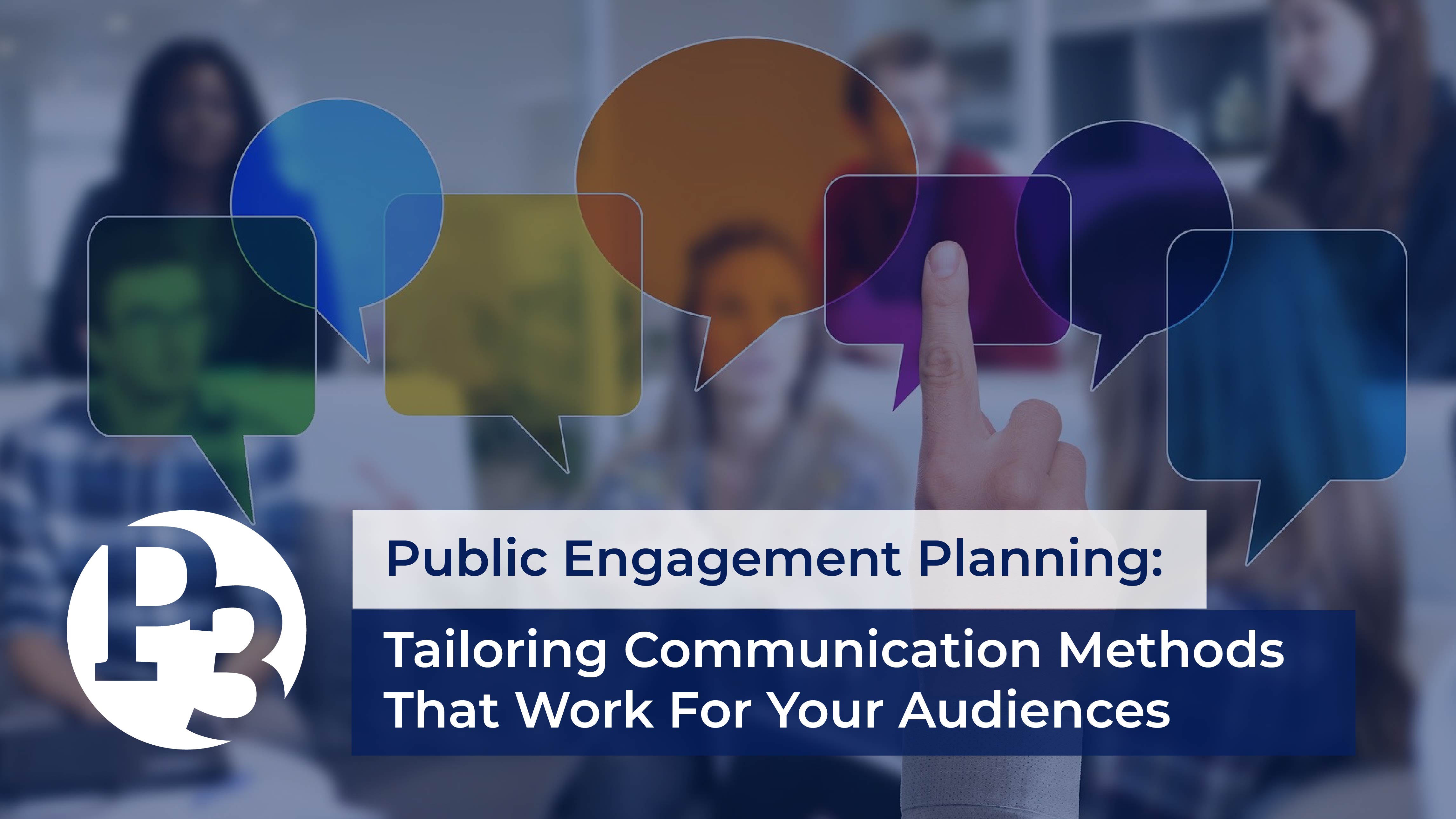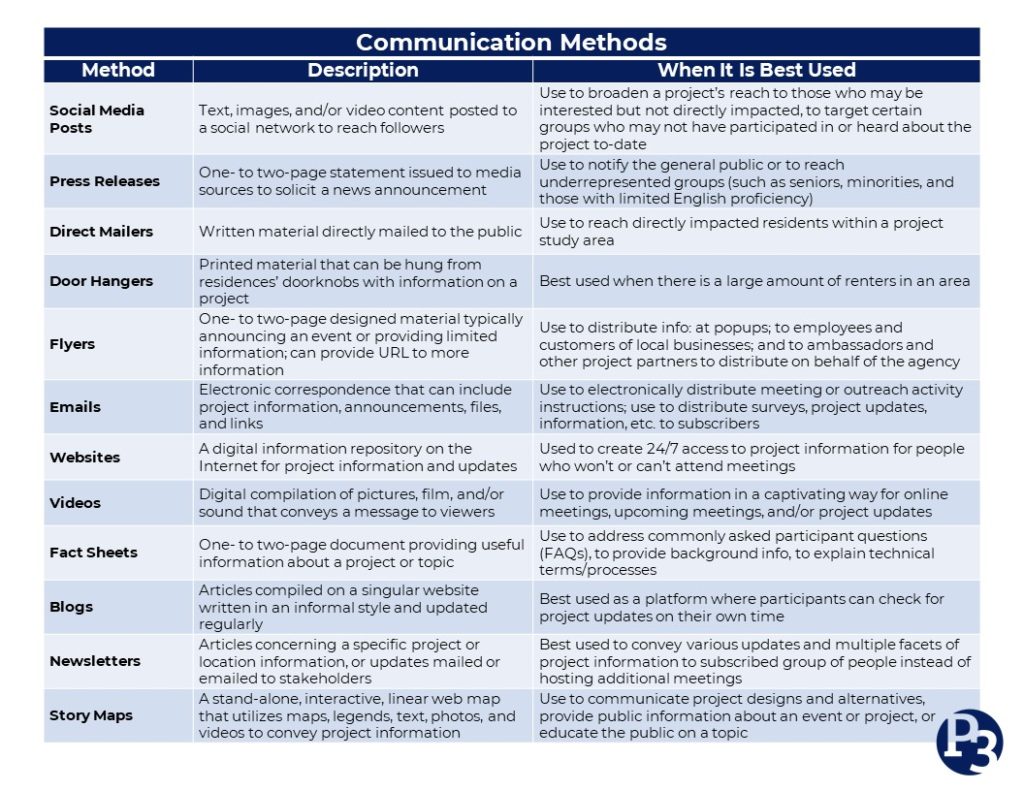
30 Nov Public Engagement Planning: Tailoring Communication Methods That Work for Your Audiences
In our previous two posts, we discussed how to select meeting and data collections that best suit your needs and the needs of your community. If you missed either of those posts, you can check them out here: https://publicparticipationpartners.com/blog (and to ensure you never miss a post again, you should subscribe for updates through our email newsletter!).
Now, you’ve developed strategies for meetings and feedback collection, but what’s the next step? How do you let the community know what’s going on and how to participate? Now it’s time to plan a communication strategy to ensure you are sufficiently prepared to reach your community. Join us for the third and final (for now) installment of our Public Engagement Planning series as we discuss best practices and tips for developing and implementing a communication strategy for your project!
You’ve come up with a meeting strategy. You determined how you will collect feedback from the public. But there’s one problem: how do you get the word out to the community so they know how to participate? The solution: devise a communications strategy.
The success of a project is directly influenced by successful implementation of communication strategies. If you are unable to effectively reach stakeholders, your project will lack the input needed to make decisions that best represent the community. Communication tools work to provide community members with the necessary information on the project and how to participate in a meaningful way.
Your strategy should incorporate multiple forms of communication messages, from working to raise awareness and educate the public about the project to sharing information about how to actively participate. The type of communication methods used will depend on your audience and the message you are trying to get across.
Here are some more tips for creating an effective communications strategy!
Keep your audience in mind.
Depending on your project’s study area, you may have more than one audience to communicate with. These audiences will influence your overall strategy for communication as well as provide insight into specific targeted communications that would be useful. Keep your targeted audience in mind when planning your strategy; some community characteristics may affect your chosen communication methods. For instance, consider access to technology; if the community does not have a lot of access to technology or Internet, perhaps try incorporating more traditional methods.
Other characteristics may influence the content within your communications. Consider languages spoken; if a large population of the community speaks a foreign language, you may want to send out translated content as well. Always consider literacy levels; if literacy levels are lower in an area, it may be necessary to simplify content (and remember, content should always be at an 8th grade reading level or lower if possible!).
Keeping the attributes of your audiences in mind will help you plan for more effective engagement that will allow them to become informed and understand how to get involved.
Understand what methods are available to choose from.
There are a variety of communication methods out there, both traditional and virtual. While it is best to incorporate multiple strategies to work to reach as many people as possible, it is also important to understand what is available to you and your agency at the time. Take your budget, staff time, and resources into consideration when planning your communication strategy. While it would be nice to be able to do it all, it is usually not feasible to do so. Come up with a strategy that fits into your project’s constraints and is achievable for you.
Just as with feedback methods, it’s necessary to incorporate both traditional and virtual communication methods if possible. Traditional methods may include door hangers, flyers, postcards, newsletters, and press releases. Virtual methods may include websites, videos, blogs, social media posts, and emails. Using a combination of traditional and virtual communication methods will ensure that you are able to communicate with as many people as possible in a community.
There are many different communication methods to choose from, and the ones you choose will depend on your purpose for communicating. The chart below highlights specific methods and when they are best used:

Don’t sleep on social media!
Speaking of budget constraints, an easy solution if you want to continue to get the word out but are lacking funding is social media! Posting organically on social media platforms is completely free, and it’s an excellent way to share information and updates with your audience in a way that is convenient for them.
Establishing a social media presence is a great way to continuously communicate with your community. Being active on various platforms, including Instagram, Facebook, Twitter, NextDoor, and more, will allow interested parties to follow you, stay informed, and interact with you throughout the project.
If you have more of a budget, you can also incorporate targeted ads! This will expand the reach of your social media posts and get the word out to even more people in your community. Need some tips on social media engagement? Check out our blog post on social media to learn more!
Carefully plan and review the information you send out.
Regardless of your chosen communication methods, it’s important to carefully plan out the content you are sending. You want to ensure that text is formatted correctly, words (including street names and other locations) are spelled correctly, and all information given is accurate and transparent. Once you draft your content, make sure to review it closely. Then, review it again! Typos or other mistakes will make your agency look less professional and can cause confusion or frustration on behalf of your audience.
Give your audience plenty of time to receive information before important deadlines.
If you are communicating information about a meeting that takes place at a certain time, or survey that closes on a certain date, make sure your communication goes out well in advance! You want to make sure that those receiving communication have ample opportunity to prepare to participate if they desire. Keep those deadlines in mind when sending out information.
Further, communicate those deadlines clearly when sending out materials. Don’t leave your audience guessing for how long they have to participate in your survey – clearly emphasize the deadline and how the recipient is able to participate before then.
Change your approach along the way if something is not working.
Just as with any other strategy, it’s important to continuously monitor and analyze the effectiveness of your communication strategies. A good way to do this is when conducting meetings or collecting feedback, ask participants how they heard about the engagement opportunity! This can help show you what methods are working best for your community and what methods aren’t reaching as many people.
If you find that some methods are very successful, try and incorporate that more in future stages of your project. If you find that some methods are not reaching many people, maybe try a different method instead. Your strategy can always change and adapt to the circumstances, so if you find that some methods are working noticeably better than others, maybe change your strategy to incorporate that analysis. It’s important to note, however, that just because a strategy is not reaching a large number of people does not necessarily mean it is ineffective. Some communication methods are better for reaching vulnerable populations or those that cannot be reached through other messages. It’s important to consider who is being reached by a method before cutting it completely – you do not want to accidentally cut off people’s access to project information and updates.
Keep these tips in mind when creating a communications strategy and look at your project and targeted audience to determine the most effective and appropriate methods for you. Our main goal as public engagement professionals is to inform, involve, and empower communities, and that cannot be done without effective methods of reaching those community members.
TL;DR
About the Author: Katie Maynard started her journey with Public Participation Partners as a Community Engagement Assistant in January 2020. When not assisting with public involvement, Katie enjoys reading, traveling to the beach, and spending time with her pets.


Sorry, the comment form is closed at this time.